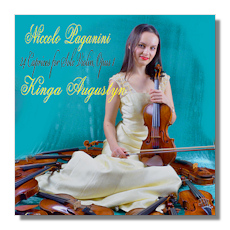
The Internet's Premier Classical Music Source
Related Links
- Paganini Reviews
- Latest Reviews
- More Reviews
-
By Composer
-
Collections
DVD & Blu-ray
Books
Concert Reviews
Articles/Interviews
Software
Audio
Search Amazon
Recommended Links
Site News
 CD Review
CD Review
Niccolo Paganini

24 Caprices for Solo Violin, Op. 1
- No. 1 in E Major "Arpeggios" (Andante)
- No. 2 in B minor (Moderato)
- No. 3 in E minor "Octaves" (Sostenuto - Presto - Sostenuto)
- No. 4 in C minor "Thirds" (Maestoso)
- No. 5 in A minor (Agitato)
- No. 6 in G minor "The Trill/Tremolo" (Lento)
- No. 7 in A minor (Posato)
- No. 8 in E Flat Major (Maestoso)
- No. 9 in E Major "The Hunt/La chasse" (Allegretto)
- No.10 in G minor (Vivace)
- No.11 in C Major (Andante - Presto - Andante)
- No.12 in A Flat Major (Allegro)
- No.13 in B Flat Major "The Devil's Laughter" (Allegro)
- No.14 in E Flat Major (Moderato)
- No.15 in E minor (Posato)
- No.16 in G minor (Presto)
- No.17 in E Flat Major (Sostenuto - Andante)
- No.18 in C Major (Corrente - Allegro)
- No.19 in E Flat Major (Lento - Allegro assai)
- No.20 in D Major (Allegretto)
- No.21 in A Major (Amoroso - Presto)
- No.22 in F Major (Marcato)
- No.23 in E Flat Major (Posato - Minore - Posato)
- No.24 in A minor (Tema. Quasi presto - Variazioni I-XI - Finale)
Kinga Augustyn, violin
Roven Records RR20016 77m
As many readers are aware, these two dozen works by Paganini are really études, each one dealing with some formidable aspect of technique. In other words, they are very difficult to play. But they also individually convey a sort of personality or mood: hear the ethereality and gossamer character suggested by #6 ("The Trill/Tremolo"), or the diabolical playfulness of #13 ("The Devil's Laughter"), or the festive cheer of #14, or the chameleon-like evolution of #24's famous theme, to cite just four examples.
I suppose a question arises here: does one listen to the Paganini's Caprices for its musical content or to be dazzled by a violinist's showmanship? Well, probably both, but I'll guess the scale tilts toward dazzle for many, at least when you hear the performance in live recital. Today, few serious listeners actually want to admit they are won over by technique and virtuosity, because after all we are all supposed to be blasé about fast octaves from a pianist or flashy double stops from a violinist. But the truth is most of us still listen (and watch) in awe as a soloist accurately and stylishly races through a thorny passage in a concerto or sonata. Those acquiring this disc of the challenging 24 Paganini Caprices can be fully satisfied both in matters of technique and interpretation.
Polish-born, New York City-based Kinga Augustyn plays with seemingly perfect intonation and otherwise impressive technique, while convincingly capturing the musical essence of each piece. Her resume is impressive too: she began studies on the violin in her native Poland at age seven and later enrolled at Juilliard, where her teachers included Dorothy Delay and Cho-Liang Lin. After earning Bachelor's and Master's degrees there, she went on to obtain a doctorate degree at SUNY, Stony Brook. She has won several competitions including the New York City-based Alexander & Buono International String Competition and the Polish-based JS Bach String Competition. She has also won prizes in other major competitions and has concertized in Europe and the US, making appearances at Carnegie Hall, Alice Tully Hall and other important venues. She has recorded for GPR Records, Naxos, and Roven Records.
Augustyn plays the set with finesse and confidence, conveying a sense these pieces are actually not a great challenge to her formidable technical skills. I liked the way she captures the plentiful effects, especially in the pieces cited in the first paragraph and also in #7 and the jaunty and mostly busy #11. She captures the playfulness in the seemingly sentimental theme in #21, deftly making it feign sadness to the point where it seems to weep, all the while using almost no portamento. Listen also to her breathless tempo in #5 and take note of how clearly she articulates the notes as she races forward.
Perlman and Midori have offered very persuasive accounts of these twenty-four pieces, but I'm not sure I'd rank them over this new performance by Kinga Augustyn. She is that good. Perlman may be a tad flashier in pieces like the busy #5, and it's certainly true that overall he's very consistent. But Augustyn seems to play with more warmth and feeling, at least in the several comparisons I made. She definitely holds her own against the plentiful competition throughout the entire set. I would say that Paganini mavens who already have the Perlman, Midori and maybe even other sets, might do well to obtain this impressive new one by Augustyn. Listeners who are new to this Paganini work, certainly will find Augustyn's performance an excellent version not only as an introduction to the music but as an enduring benchmark. The sound reproduction from Roven Records is quite good. Highly recommended.
Copyright © 2016, Robert Cummings












